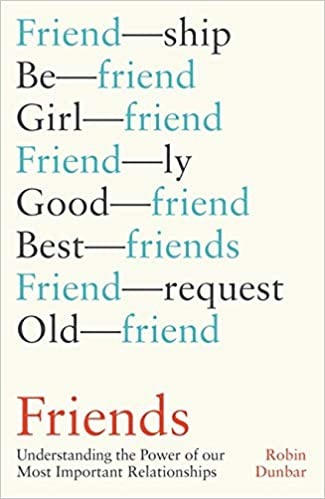Written by Matthew Archer.
The following post lifts most of its material from Robin Dunbar’s 2021 book, Friends. I highly recommend it.
Take a look at the following two jokes. Do you notice any structural differences between them?
Joke 1:
At the airport they asked me if anybody I didn’t know gave me anything. Even the people I know don’t give me anything!
Joke 2:
A young boy enters a barber shop and the barber whispers to his customer, ‘This is the dumbest kid in the world. Watch while I prove it to you.’ The barber puts a dollar bill in one hand and two quarters in the other, then calls the boy over and asks, ‘Which do you want, son?’ The boy takes the quarters and leaves. ‘What did I tell you?’ said the barber. ‘That kid never learns!’ Later, when the customer leaves, he sees the same young boy coming out of the ice cream store. ‘Hey, son! May I ask you a question? Why did you take the quarters instead of the dollar bill?’ The boy licked his cone and replied, ‘Because the day I take the dollar, the game is over!’
It’s fairly obvious that the second joke is more complex, but how precisely? The answer is that it involves higher order intentionality.
Intentionality refers to mindstate terms like think, believe, wondering, suppose, intend, and want. Your mentalising capacity refers to how many mindstates you can understand. Dunbar and his colleagues have found that five orders of intentionality is probably what the average meat computer can handle. Here’s his example of a sentence with five mindstates:
I believe that you wonder whether Jim expects that Jemina intends to ask Sally whether she is in love with Fred. Only 20 per cent of people can do better than that. We have since confirmed these results in around half a dozen subsequent studies.
And here’s Dunbar’s example of six recursions:
I think that you believe that I am wondering why you suppose that I intend to do the opposite of whatever you want me to do.
I don’t know about you, but I have to read a sentence like that slowly and twice! In this regard, “mentalising capacity” is clearly just another euphemism for (verbal) intelligence. We’d obviously expect that the 20 per cent of people who can easily go beyond five mindstates have above average verbal ability. It’s almost tautologous.
Indeed, as someone interested in giftedness, I find it surprising that I’ve never read about using orders of intentionality questions to measure IQ. You could give subjects timed statements and make them answer questions on its content, kind of like the syllogism questions many tests already contain.
But back to the jokes. What’s interesting is that people rate the more complex jokes as funnier! However, five mindstate jokes appear to be the limit. Beyond that, most people aren’t able to hold the narrative in their head and hence their humour rating drops off a cliff.
One of Dunbar’s colleagues, James Carney, composed two different sets of short stories. The first set capped the mentalising at third order intentionality, the second set went up to the fifth order. Before giving subjects the stories, Carney assessed people’s mentalising capacities. Subjects then rated Carney’s stories for enjoyment and engagement. Predictably, he found that the smarter people got bored by the three-mindstate stories and the duller people enjoyed them.
The social world is more complex than the physical
Comprehending the social world is complex. In fact, another of Dunbar’s colleagues, Amy Birch, sought to demonstrate that it is actually more complex than understanding the physical world — at least the Newtonian version. Whilst her fMRI study suffers from the usual small sample issues, it’s still interesting and a great design. Here’s Dunbar:
[Birch] compared how much work the brain was doing when it was working out mentalising questions with different numbers of mindstates compared with when it was working out just the physical elements of the story (that someone did something rather than intended to do something). When we matched the number of propositions involved (each mindstate is, after all, a proposition: ‘Jim thinks something’ has the same grammatical structure as ‘Jim does something’), mentalising tasks were much harder than working out causal relationships in the physical world, and became disproportionately harder the more mindstates involved.”
Why would this be? Dunbar answers:
[…] when we think about other people’s minds, we are actually modelling their mindstate in the virtual space of our own mind, whereas physical relationships (something causes something else) are simply there in front of you in the sense of being simple factual memories. A mindstate is one step further removed from reality than a physical event because you have to use indirect cues to figure out what someone else is thinking. One is about the evidence for something, the other is about inferring something that you can’t see when the evidence (what you say or how you look) and the mindstate behind the evidence are qualitatively different. The second will inevitably be computationally more difficult. Your grimace is not the same thing as the pain you are experiencing; it certainly reflects your state of mind, but I have to make that inference and I do that on a balance of probabilities because grimaces can in fact imply many different mindstates from pain to irony to ‘Oh, for heaven’s sake, that really was a bad joke . . .’
Brain size, mentalising capacity, and shit Neanderthal storytelling:
Because brain size correlates with intelligence “mentalising capacity”, Dunbar was able to do something rather cool: estimate how many orders of intentionality neanderthals were capable of:
On the basis of their brain size, we estimate that the now extinct Neanderthals of Europe and the other archaic humans that dominated the half-million years of our evolutionary history before modern humans appeared could only have managed fourth-order intentionality. That one order of intentionality difference would have had a dramatic effect on the complexity of the stories they could tell and the number of people they could hold in a conversation.
And that’s why a Neanderthal has never won the Nobel Prize for Literature.
Evolution and group size
Dunbar’s theory of language postulates that language evolved as an efficient way of social grooming. Connecting the brain size and mentalising research with this theory, we can thus ask whether communication becomes more complex as groups become larger? Dunbar:
Across primates as a whole, both vocal complexity and gestural complexity increase with the size of the social group that characterises the species. In fact, this was first demonstrated in a clever set of studies on wild Carolina chickadees (a small North American bird related to European tits) by Todd Freeberg: even within the same species, their vocalisations become more complex when they live in larger groups – the more individuals you need to ‘speak’ to, the richer your language has to be to ensure that communication is unequivocally directed at, and received by, the individual it is meant for.
There are many other fascinating studies in Dunbar’s book. It’s well worth the read if you want to understand why friendship is so vital to human well-being.
Matthew Archer is Editor-in-Chief of Aporia.
Follow us on Twitter and consider supporting us with a paid subscription for just $6.99 a month:















How conversations, stories, and jokes are IQ tests